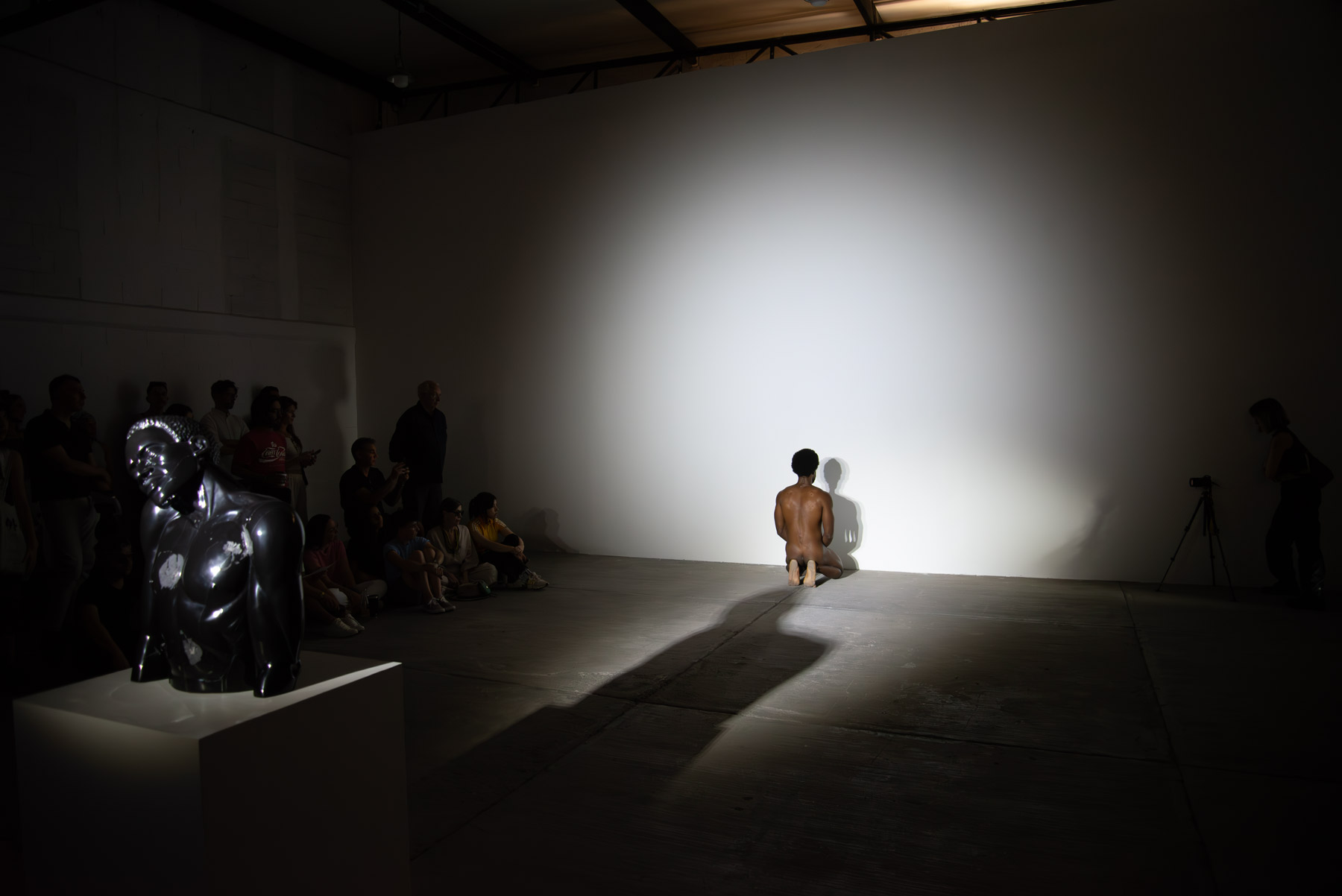


Devoid of visual and acoustic discrepancies, the silent and pristine character of the art space is naturally attuned to the topological imaginary of a secular temple. Sheltered from the chaos, commotion and violence of the outside world, the gallery becomes a remote and abstract echo of all that bustle, hygienically filtered by literally harmless concepts. The white cube, or the institution it rep- resents, is composed of “seemingly benign architectural features (…), coded mechanisms that actively disassociate the space of art from the outer world, furthering the institution’s idealist imperative of rendering itself and its hierarchization of values “objective”, “disinterested”, and “true””1. Thou shalt touch nothing, yet thou shalt idolize everything.
Carlos Martiel has integrated into his body of work the symbolic disturbance of the space in which he presents his performances; most of these are site-specific and intrinsically linked to the geographical, cultural and political context in which they are presented, since the artist never repeats the same action. Martiel’s own body is often the axis of all his actions: the point at which the inherent tension, conflict, and humanity that his practice encompasses in all its earthly rawness is condensed. In his work, the body is always found in a liminal space of difficulty, submission or pressure, in which the physical integrity of the man, and not only that of the artist, is also compromised. Martiel fragments and reconstructs his corporality according to the purpose of his piece, going from embodying a faceless sediment on the streets of Los Angeles to erecting an anti-monument in handcuffs standing on a plinth in the lobby of a New York institution. His chest becomes the canvas on which he successively nails his father’s military medals awarded by the Cuban government, his head a plundered anthropological vestige offered to the eyes of the West in a museum display case, his veins a pool of blood that merges with the salt of the waves that break ceaselessly against the Havana seawall.
In Calibre Martiel disrupts the deceitful sanctuary of the art space and shatters it without hesitation: the gallery is no longer the place where the body is forgotten but the context in which its integrity is violated under our passive and collective protection. In this wildly iconoclastic reality, anything can happen: relics and scriptures are transgressed, norms of conduct are outraged, and the person next to you, with their innocent air and Mubi tote bag, can be to you what the wolf was to Hobbes. The gunslinger who assaults the artist in this brief action has no face; or rather, it has all faces. Calibre urges us to consider that our gaze is, in its raw and pure state, and before any reaction intervenes, driven by subjective instinct or Levinasian ethics, the pristine and impassive accomplice to the routine massacre that we all, together, sustain. The gaze is the tacit and primitive trigger, the shot in the making.
For his third performance in Mexico City, the artist duplicates his own body, contrasting its organic physicality with that of the sculpted marble in his piece Amarillismo (2024) at the other end of the room. A noble stone desecrated by bullets and exposed, shamelessly, to our gaze. Thus the grotesque carcasses of those wretched and nameless John Does in the morbid crime chronicles that cover the yellowing newsstands of our necro-States. Could it be that in the daily and random misfortune of these poor fellows, an “elementary catharsis” awaits us as we behold the transformation of “tragedy into spectacle”2, in the words of Monsiváis? This would imply becoming a believer in the absolution offered by abjection, and to heroically resist the classist temptation to dismiss the tabloid press as the entertainment of the commoner. But abjection splatters and ripples through. And, sacrilegious as it is, it also spills onto the sacrosanct gallery. “The cruelty of [some art] pieces […] may start with a certain cruelty to the self, but that cruelty quickly leaks out to the viewer. The artists are not content to stare at the camera and ask, ‘Why are you still looking?’ Instead, they ask, ‘How will you participate in this?’”3 Perhaps the ultimate catharsis, the one that redeems us and condemns us at the same time, is the realization that cathartic experience is and always has been a worn-out syllogistic myth. Like violence, “when art works best,” says cultural critic Maggie Nelson, “it doesn’t really say or teach anything. The action is elsewhere.”4
Thus the temple of Aristotle collapses on us. And tears us apart.
How tempting is it to admire the fire while it consumes us before demanding for it to cease?
Text by Adrian de Banville
–
*Carlos Martiel is currently showing Cuerpo a solo exhibition at El Museo del Barrio, New York.
1 Miwon Kwon, One Place After Another: Notes on Site Specificity, 1997 2 Carlos Monsiváis, Fuegos de nota roja, 1992
3 Maggie Nelson, The Art of Cruelty, 2012
4 Ibid